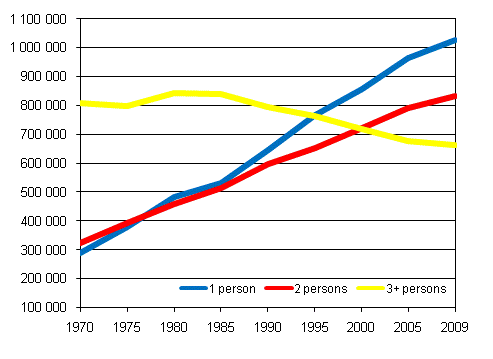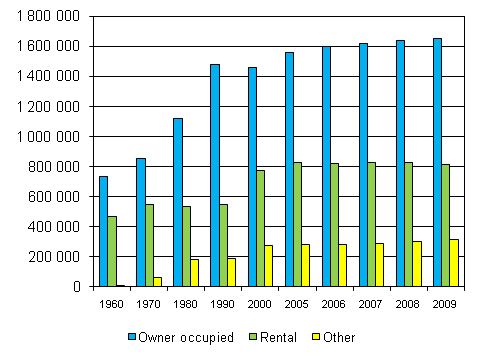2. Household-dwelling units and housing conditions 2009
Average size of household-dwelling unit 2.08 persons
The number of household-dwelling units with one and two persons has been growing for several decades, being 74 per cent of all household-dwelling units at the end of 2009. At the end of 2009, the total number of household-dwelling units was 2,517,000, of which 1,026,000, i.e. 41 per cent, were single-person household-dwelling units. In 2009 the average size of a household dwelling unit was 2.08 persons, while in 1970 it was still three persons.
Figur 1. Number of household-dwelling units by size in 1970–2009, number

The size of a household-dwelling unit varied regionally. In urban municipalities the average size of a household-dwelling unit was 2.03 persons and in rural municipalities 2.22 persons. The structure of household-dwelling units differs between rural and urban areas. The share of one-person household-dwelling units is larger in urban areas (43%) than in rural areas (37%).
One household-dwelling unit had around 81 square metres of living area at its disposal, or 39 square metres per person. The floor area per person diminishes considerably as the size of the household-dwelling unit grows. The average area available for a single person living alone was 58 square metres, a two-person household-dwelling unit had 43 square metres per person but a household-dwelling unit of six persons had no more than 21 square metres of floor area per person.
Table 2. Floor area per person (m2) by size of household-dwelling unit in 1985–2009
| Year | Number of persons | |||||||
| All household-dwelling units | 1 person | 2 persons | 3 persons | 4 persons | 5 persons | 6 persons | 7+ persons | |
| 1985 | 28,9 | 48,6 | 34,3 | 27,6 | 24,1 | 21,2 | 18,7 | 15,2 |
| 1990 | 31,4 | 51,8 | 37,0 | 29,4 | 25,0 | 21,7 | 19,0 | 14,8 |
| 1995 | 33,4 | 54,0 | 39,2 | 30,4 | 25,3 | 21,9 | 19,0 | 15,0 |
| 2000 | 35,3 | 55,6 | 40,8 | 31,4 | 26,0 | 22,5 | 19,4 | 15,4 |
| 2005 | 37,5 | 57,0 | 42,4 | 32,3 | 27,3 | 23,7 | 20,4 | 16,3 |
| 2009 | 38,9 | 58,3 | 43,4 | 33,0 | 28,1 | 24,4 | 21,0 | 16,8 |
Owner-occupied dwellings have more living space than rented dwellings, when measured by floor area per person. The average floor area per persons of a household-dwelling unit living in an owner-occupied house is 41 square metres, while a unit living in a rented dwelling only has 32 square metres of floor area per person.
Of rental dwellings, non-subsidised rented dwellings had the most floor area per person, 33 square metres. Differences to other rental dwellings were not large. In government-subsidised rented dwellings the floor area was 31 square metres per person and in interest-subsidised rented dwellings 30 square metres. In right-of-occupancy dwellings the living space per person was 32 square metres.
One in four Finns lives in overcrowded dwelling
At the end of 2009, the number of household-dwelling units living in overcrowded dwellings was 228,000 and the total number of persons living in such dwellings was 942,000. A household-dwelling unit is defined as living in an overcrowded dwelling if it consists of more than one person per one room of its dwelling, so a person living alone cannot be regarded as living in an overcrowded dwelling. One-person household-dwelling units excluded, 15 per cent of the rest of the household-dwelling units and almost one person in four lived in an overcrowded dwelling. Compared with the year before, the number of overcrowded household-dwelling units remained almost unchanged, but the number of persons living in overcrowded dwellings fell by around 5,000.
One quarter of the population live in rented dwellings
The proportion of rented dwellings of all permanently occupied dwellings was 30 per cent, but 1.3 million, or one quarter of the population, lived in rented dwellings. The reason for this difference is that smaller household-dwelling units live in rented dwellings than in owner-occupied dwellings. Of all dwellings, the number of rented dwellings was around 814,000 at the end of the year 2009. The number of rented dwellings has grown by 269,000 since 1990. At the end of 2009, there were 33,000 right-of-occupancy dwellings in Finland. Forty-three per cent of them are located in Greater Helsinki.
Figur 2. Dwellings by tenure status 1960–2009

Renting is a tenure status preferred by young household-dwelling units in particular. As the age of the oldest person of a household-dwelling unit goes up the proportion of those living in rented dwellings goes down. In all, 70 per cent of the household-dwelling units with the oldest person aged under 30 and nearly one third of those with the oldest persons aged 30 to 44 lived in rented dwellings, while only 21 per cent of the household-dwelling units where the oldest person was aged over 45 did so. The household-dwelling units where the oldest person was aged 45 to 74 were the most likely to own their house. Forty-three per cent of the households-dwelling units meeting this age criterion were owner-occupiers of detached houses. In contrast, when the oldest person in the household-dwelling unit was older than this, owning a house was less likely. The most common mode of dwelling at a later stage in life was an owner-occupied flat in a housing corporation.
The number of blocks of flats with no lift relatively high
The number of blocks of flats with more than three storeys was around 22,000, of which 3,300 had no lift. Dwellings in blocks of flats with more than three storeys and no lift numbered 108,000 and had 147,000 occupants, of whom 24,000 are aged over 65. It was even less usual to have a lift in a three-storey building. Thirteen per cent of the 340,000 dwellings in buildings with three storeys were in blocks of flats with a lift. In all, 432,000 Finns, of whom 72,000 were aged over 65, lived in three-storey buildings with no lift.
Source: Dwellings and Housing Conditions, Statistics Finland
Inquiries: Marja Hermiö (09) 1734 3211, Arja Tiihonen (09) 1734 3272, Elina Aspblad-Huohvanainen (09) 1734 3232, asuminen@stat.fi
Director in charge: Jari Tarkoma
Updated 12.11.2010
Official Statistics of Finland (OSF):
Dwellings and housing conditions [e-publication].
ISSN=1798-6761. Overview 2009,
2. Household-dwelling units and housing conditions 2009
. Helsinki: Statistics Finland [referred: 19.4.2024].
Access method: http://www.stat.fi/til/asas/2009/01/asas_2009_01_2010-11-12_kat_002_en.html

